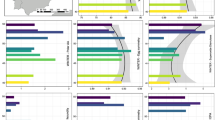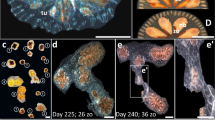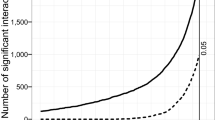Abstract
MACARTHUR and Wilson1 coined the terms r selection and K selection to describe two general kinds of selection they believed could be functioning in nature (K refers to carrying capacity and r to maximal intrinsic rate of natural increase, rm). As originally defined, the r and K selection concepts postulated that alternative genotypes within a species possessed somewhat divergent life history characteristics : genotypes with a high rm were suggested to have a relatively low K and vice versa1. Thus, r selection occurs in a fluctuating environment when there is no crowding and it is more important to increase the size of the population. K selection occurs in stable environments when population size is always near the maximum and increasing efficiency in resource use is required for the production of a few but extremely fit offspring. Pianka2 extended these concepts to include comparisons of individuals of different species. He postulated that no organism is completely r selected or completely K selected, but all must reach some compromise between the two extremes. Thus, a given species could be visualised along an r–K continuum and identified by a set of r and K characteristics2.
This is a preview of subscription content, access via your institution
Access options
Subscribe to this journal
Receive 51 print issues and online access
$199.00 per year
only $3.90 per issue
Buy this article
- Purchase on Springer Link
- Instant access to full article PDF
Prices may be subject to local taxes which are calculated during checkout
Similar content being viewed by others
References
MacArthur, R. H., and Wilson, E. O., The Theory of Island Biogeography (Princeton University Press, New Jersey, 1967).
Pianka, E. R., Am. Nat., 104, 592–597 (1970).
Loya, Y., Mar. Biol., 13, 100–123 (1972).
Slobodkin, L. B., and Sanders, H. L., Brookhaven Symp. Biol., 22, 82–93 (1969).
Colwell, R. K., Ecology, 55, 1148–1153 (1974).
Loya, Y., Mar. Biol., 29, 177–185 (1975).
Loya, Y., and Slobodkin, L. B., Symp. zool. Soc. Lond., 28, 117–139 (1971).
Dobzhansky, T., Am. Scient., 38, 209–221 (1950).
Rinkevich, B., thesis, Tel-Aviv Univ. (1975).
Connell, J. H., Biology and Geology of Coral Reefs, Vol. 2, Biology, 205–245 (Academic, New York, 1974).
Slobodkin, L. B., Growth and Regulation of Animal Populations (Holt Rinehart Winston, New York, 1961).
Hutchinson, G. E., Ecology, 32, 571–577 (1951).
MacArthur, R. H., Am. Nat., 94, 25–36 (1960).
Lewontin, R. C., The Genetics of Colonizing Species, 79–94 (Academic, New York, 1965).
Baker, H. G., The Genetics of Colonizing Species, 147–172 (Academic, New York, 1965).
Lang, J. C., Bull. mar. Sci., 21, 952–959 (1971).
Lang, J. C., Bull. mar. Sci., 23, 260–279 (1973).
Author information
Authors and Affiliations
Rights and permissions
About this article
Cite this article
LOYA, Y. The Red Sea coral Stylophora pistillata is an r strategist. Nature 259, 478–480 (1976). https://doi.org/10.1038/259478a0
Received:
Accepted:
Issue Date:
DOI: https://doi.org/10.1038/259478a0
This article is cited by
-
Size structure of the coral Stylophora pistillata across reef flat zones in the central Red Sea
Scientific Reports (2022)
-
Morpho-functional traits of the coral Stylophora pistillata enhance light capture for photosynthesis at mesophotic depths
Communications Biology (2022)
-
Linking population size structure, heat stress and bleaching responses in a subtropical endemic coral
Coral Reefs (2021)
-
Upper mesophotic depths in the coral reefs of Eilat, Red Sea, offer suitable refuge grounds for coral settlement
Scientific Reports (2019)
-
Stylophora pistillata in the Red Sea demonstrate higher GFP fluorescence under ocean acidification conditions
Coral Reefs (2018)
Comments
By submitting a comment you agree to abide by our Terms and Community Guidelines. If you find something abusive or that does not comply with our terms or guidelines please flag it as inappropriate.



